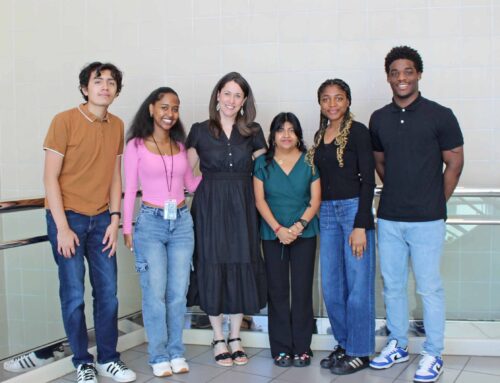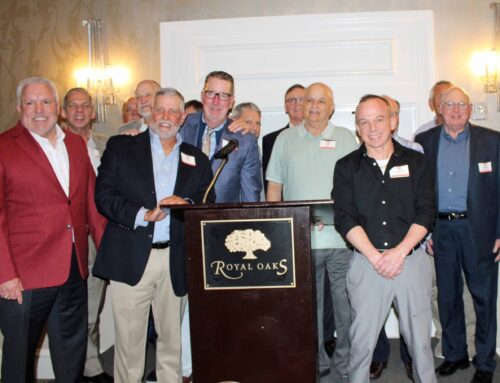You don’t hear much about them, even though they are in the majority at Lake Highlands High School.
They don’t carry guns or belong to a gang.
They aren’t flunking out of school.
They don’t take drugs.
Their idea of fun isn’t holding up a convenience store or shooting out a window.
They are typical Lake Highlands students, doing their best with what they have, and they’re doing a pretty good job. Unfortunately, we don’t hear much about these “good eggs” because, it seems, they aren’t doing anything bad.
The Advocate spent some time recently at Lake Highlands talking to students and administrators to see what’s really going on in our public schools.
We talked about violence, guns and gangs, which are not as prevalent as everyone thinks.
We talked about drugs and alcohol, which concern everybody.
We talked about education and the role of the school and educators, which is constantly changing.
“Teenagers, basically, have been and are the same as they were 26 years ago,” says Lake Highlands principal Ron Mathews. “What has changed are the temptations around them.”
“The availability of guns and random violence make it more difficult today, even though we don’t have the worst of times.”
But despite the negative media images, Mathews says most students do well, and Lake Highlands still provides a good education.
“There’s no such thing as a bad kid,” Mathews says. “The vast majority of students are wholesome and respectful.”
“The chemistry on the Lake Highlands campus is a caring atmosphere and a feeling of trust. The students know they will be treated with care and respect. Students, generally, don’t have problems here because they trust us.”
The Misconception
Benjie Slaton, an 18-year-old senior, says his grandfather probably would be surprised – positively and negatively – if he walked through the halls of Lake Highlands.
“The older generations see we’ve changed a lot,” Slaton says. “The demands are greater. But we were brought up to handle them.”
A lot of adults who hear negative reports about drugs and violence in schools automatically believe all teenagers are like that, Slaton says.
“It’s a very small minority of the students who do that,” Slaton says. “The adults focus on the mistakes, not all the good things we’re striving for.”
“I think we’re above the average, typical high school student,” Slaton says. “For the most part, we’re not a bunch of hoodlums like a lot of people think.”
Donna Clark, a senior counselor at Lake Highlands, says some of the negative stories about schools are true, but they are the exception rather than the rule.
“You’re going to sensationalize the real bad and the real good,” Clark says. “Ten percent of the kids do that bad stuff. Ten percent of the kids do that good stuff. Eighty percent of the kids fall in the middle.”
“If we have a problem, we face it and deal with it. We don’t sweep it under the carpet.”
“I don’t think parents need to be scared,” Clark says. “Parents need to be realistic.”
Walking through the halls of Lake Highlands, what you see is what you get, Clark says. Students walk to classes, talking and saying hi to each other. The normal attire is jeans with sweaters or button-down shirts.
“Our kids look real average,” Clark says. “They look real normal. When I talk about Lake Highlands, I talk about good kids. We have had a lot more good kids than bad kids.”
Kara Packard, an 18-year-old senior, says what happens at school and your perception of it depends on who you hang out with.
“You make it what you want it to be,” Packard says.
Despite what is reported about schools, she says she feels safe in Lake Highlands’ halls.
“As amazing as it seems,” Packard says.
“I believe them (news reports). But I’m glad I’m here. I’m sure it goes on here, just not in the extremes.”
Lindsey Gall, a 16-year-old junior, says she and her parents are happy with the education she is receiving from neighborhood public schools. But she says her parents are considering sending her youngest brother, who is in the fifth grade, to a private school.
“I guess they would think it was safer,” Gall says. “There’s things that go on outside of school. But I think it’s safe to be here.”
Gall says she is sure some of her classmates have a rough life and that can contribute to their performance.
“I think people make them out to be worse than they are,” Gall says. “There may be some people who are bad, but the school isn’t.”
Mathews says in the last three years, there have been two incidents with weapons on the Lake Highlands campus. Last school year, there were five fights; so far this year, there have been four.
But when you have 1,650 students under one roof, those are good odds, he says.
“I think the guns and violence will get better,” Mathew says. “That pendulum will swing. The reason it will change is because society is demanding it gets better. We’ve bottomed out.”
Changing Times
Clark, the counselor, has worked at Lake Highlands for 22 years. Her husband, who is an assistant principal at the high school, has been in education for 23 years in Lake Highlands, 17 of those years at the high school. They have watched students change in the last 20 years.
Today’s students still have the same worries about graduating, class rank and GPA, but there are also a lot of different things affecting their lives, Clark says.
“Kids today do have to deal with a more violent society,” Clark says. “They do have to watch their back.”
Clark recently talked with a student who was upset because she thought her 2 a.m. curfew was too early. Clark says 20 years ago curfews were 10 p.m. for sophomores, 11 p.m. for juniors and midnight for seniors – and no one questioned them.
“Dallas is a meaner city than it used to be,” Clark says. “Vandalism 22 years ago was wrapping someone’s house in toilet paper. Vandalism today is shooting out someone’s window.”
“I don’t think kids value life like they used to. I think kids see themselves as immortal. It’s a lot harder to grow up today.”
Kent Ackmann, an 18-year-old senior, agrees that being a teenager today is different.
“There’s enormous pressure put on us,” Ackmann says. “They didn’t have to deal with the drugs and alcohol like we have to.”
But Ackmann says if a Lake Highlands student decides to be bad, it is a personal decision because the school and community provide plenty of good opportunities.
“Everybody wants to succeed,” Ackmann says. “Nobody comes in here and says I want to fail. Just being involved helps everything.”
Ackmann plays football and serves on the student council. He will be going to Morningside College in Sioux City, Iowa, on a scholarship next year and wants to study business or communications.
“If you work hard, things will come to you,” Ackmann says.
Mathews says the media and entertainment industries promote an “if it feels good do it” perception to teenagers, which can have detrimental effects they don’t realize. However, there are many parents in Lake Highlands who help their children make good choices.
“But at the same time, they’re working upstream or against the odds of society,” Mathews says.
Too many things have changed in the last 20 years, Mathews says, and we can’t expect to go back to the way it was, so our schools have to change also.
“What we will not do is go back in time to two-parent, caring families where the wife stays home, and we all sit around the dinner table and watch ‘Leave it to Beaver,’” Mathews says.
The Education
Education techniques are constantly improving, but at the same time, the role of the educator is becoming more difficult, Mathews says.
“The student today is different,” Mathews says. “It’s a whole different kind of child. The child is less prepared, and guess what? He’s leaving less prepared.”
But, overall, Mathews says Lake Highlands students do well. Each year, 85 percent of the graduating class enters college.
“A majority of them have been or will be successful adults in society,” Mathews says. “That hasn’t changed in 30 years.”
Teachers and administrators at Lake Highlands have united to make sure every child gets the best education possible, Clark says.
“I’m a public school advocate,” she says. “Public schools offer good education and real life.”
Five percent of this year’s seniors are at risk of not passing the TAAS test, a requirement to receive a high school diploma, Clark says. Those students have been targeted and are being tutored for the test, she says.
The school’s library is open at night. There is a writing lab with computers open until 6 p.m. There is a technology lab with modern audio and video equipment. And this year, Lake Highlands had 11 National Merit Finalists.
Students receive monthly newsletters from counselors. Lists of available college scholarships are circulated and posted for students. The school walls are decorated with posters for colleges and educational programs.
“We offer so many things for the kids, if they take advantage of it,” Clark says. “Sadly enough, it’s not enough. There’s only a few of us.”
“My husband and I are both in education. We are at the school more than we are at home. The parents have to help. The school’s responsibility is to take these kids eight hours a day and educate them. The family’s responsibility is to teach them citizenship.
“When you don’t have that family, when you don’t have that support, it won’t work.”
Julie Gillis, an 18-year-old senior, says Lake Highlands provides more than just a good academic education.
She attends classes for the first three periods of the day. Then she has lunch, and fourth period is spent participating in student council activities. In the afternoon, she participates in a management training program that allows her to student-teach at an elementary school.
“I think this high school is a good setting because there is a variety of people and activities,” Gillis says. “This community and school is exceptional. I’ve had a great three years here.” And that experience, Mathews says, is the goal.
“We do not run a prison. We do not have guards at the door. We operate a public building,” Mathews says.
“Schools are the backbone of the Lake Highlands community. Every school is different, like every home is different. The tone we set is a positive, caring atmosphere.”





